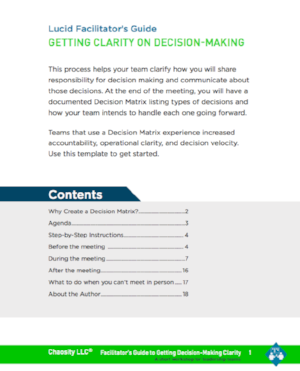How to Create a Decision Matrix with Your Team (and why you need one!)

Introducing Tammy Spann
The Lucid Meetings team is delighted to welcome our newest template designer, Tammy Adams Spann. We first met Tammy at a workshop she and David Spann conducted on decision making in meetings (a topic near and dear to our hearts) where they introduced Eric Coryell’s Decision Matrix. We love the clarity the Decision Matrix brings to decision-making for leadership teams. We’re thrilled Tammy agreed to share her process for helping teams get clear on how key decisions will be made by filling out your own Decision Matrix.
Read on to learn how Tammy learned this technique and get her guide to using it in your organization.
— Team Lucid
Have you ever given your opinion and had it implemented as a decision? Worse yet, have you made a decision only to have it overridden by someone higher up the food chain?

As a professional facilitator, I’ve worked with teams that are reticent to take on the responsibility (and consequences) that go with making a decision. Similarly, I’ve heard leaders complain that their teams expect them to make every decision. If any of this sounds familiar, the Decision Matrix is a tool you’ll want to explore.
The Decision Matrix was the brainchild of Eric Coryell, president of Core Connections LLC.
When I heard Eric speak about this tool in a webinar, I immediately recalled all the leadership teams I’ve worked with that struggle with role clarity—the basic question being what’s mine, yours and ours. It has become a staple in my facilitation tool bag.
One recent example of its use was with a small company that shifted from the typical top-down silo organizational structure into cross-functional business units last year. Prior to the shift, all decisions were made at the top of the silo.
The new structure begged the question…what authority do we have as business units to make decisions?
I started with the leadership team and asked them to brainstorm all the types of decisions that get made in the organization. We then divided the decisions into two groupings – decisions that will continue to be owned by the leadership team and decisions that are now owned by the business units. This was then reviewed, discussed and revised with all parties.
Just this simple step was received with excitement and enthusiasm!
The business units now have the authority to make key decisions rather than waiting for permission from above and the Executives can now focus on the directional decisions that are key to organizational success.
Example Decision Matrix
Here’s an example of what the Decision Matrix looks like after it’s been filled out. You will find a blank Word template for creating your own Decision Matrix included with the guide linked below.
| Category | Who Decides | Decisions That Need to Be Made |
|---|---|---|
| 1 | Tammy (leader) | Setting goals for our metrics |
| 1 | Tammy | Capital expenditures prioritization and execution |
| 2 | Sheila | Determining if we are going to work holidays |
| 2 | Sheila | Deciding when to hire a new production employee |
| 3 | Sheila | Establishing resource priorities |
| 3 | Sheila | Overtime decisions (Operators) |
| 3 | Sheila | Ordering temps |
| 4 | Sheila | Disciplinary process (Team Leads for severe/potential dismissal) |
| 3 | Allen | Firing operators |
| 2 | Paul | Changing label supplier |
| 4 | Paul | Changing any shop supplies providers |
| 2 | Exec Team | Expenses over $500 per line item |
| 3 | Exec Team | Leveraging resources from other departments |
| 3 | Team Leads | Expenses less than $500 per line item |
| 4 | Team leads | Disciplinary process (Operators) |
| 4 | Prod. Team | Who to hire for a new production employee |
Key to Decision Categories
- Leader decides (with or without input)
- Team or individual decides; leader wants to know before the decision is made
- Team or individual decides; leader wants to know about it afterwards
- Team or individual decides; leader doesn’t need or want to know about it
Next Steps
In February, we’ll reconvene to take the next step; defining who owns the decisions within each team using the categories defined in the decision matrix guide. If you haven’t guessed already, this is an iterative process.
It’s not about getting it “right” the first time; it’s about the journey toward clarity.
I’m happy to share with you this process that I use with teams who are interested in taking that first step.
Facilitator’s Guide
The Meeting Facilitator Guide for Getting Clarity on Decision-Making
This download includes:
- 20-page Facilitator’s Guide PDF
- Meeting setup and equipment list
- Step-by-step meeting instructions
- A Word template and example you can use to create your Decision Matrix




